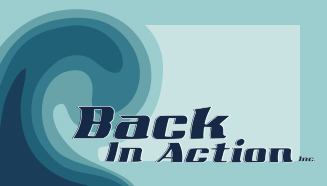What types of conditions are treated at Back In Action?
Several conditions involve joint and muscle pain stemming from strains and sprains, disc protrusions and herniations, poor posture, motor vehicle accidents, work related mishaps, sports related mishaps, and progressive wear and tear. Given the choice of conservative measures or surgery, oftentimes patients choose to attend physical therapy aiming at healing without surgical intervention. Even if surgery is ultimately needed, improving one's overall condition prior to the procedure can assist with expediting post–surgical rehabilitation.
Neurological conditions are also treated and they include CVA (stroke), Guillain-Barre Syndrome, and causalgia. Women's health diagnoses include incontinence, pelvic pain, pain associated with pregnancy and childbirth, muscle and joint pain stemming from handling a growing baby which I call "New Mom Syndrome," dyspareunia (painful intercourse) and interstitial cystitis.
It brings me great joy when treating women’s health concerns regarding incontinence and pelvic pain, as these issues are often embarrassing and they keep women from participating in numerous activities. Resolving incontinence and pelvic pain truly get women back in action! Please refer to the Prometheus Group link to view the electrodes and electrical stimulators often used to rehabilitate women’s health issues.
Another of my specialties is resolving back and sacral pain due to pelvic asymmetries. These asymmetries can lead to not only pain, but also to incontinence, weakness, and numbness and tingling in the legs. Restoring alignment restores function and resolves pain.
Altering footwear with inexpensive shoe inserts can resolve conditions from the foot all the way up to the neck. The products I use support the forefoot and/or the heel to optimize your step—and yes, the products work in slippers!!!
Back In Action strives to help patients help themselves down the road to recovery. Manual interventions and modalities complement body mechanics training and a postural strengthening routine which can be continued with a custom home exercise program.
What types of incontinence can be treated with physical therapy?
Stress Incontinence is defined by difficulty or inability to control urinary and/or fecal leakage with increased abdominal pressure. Such pressure is exerted with physical activity, sneezing, laughing, and coughing. Generally the pelvic floor muscles are weak or inactive, leading to the inability to contract against the pressures placed on the bladder. Strengthening the pelvic floor muscles can be achieved with specific, isolated pelvic floor exercises. Therapeutic activities improve the timing of contraction to retrain the pelvic floor to automatically contract against the external bladder pressure. Oftentimes it is difficult to sense leakage making it difficult to know when to contract the pelvic floor. If contraction is not achieved sufficiently, an internal, electrical vaginal set at a frequency of 50 Hz can be used to not only "find" the muscles, but also to enhance their contraction. Such stimulation also awakens the nerve endings helping them to sense to the presence of urine, triggering the muscles to contract. Please refer to the Prometheus Group link to view the equipment used.
Furthermore, if you have a problem controlling urine flow even when the bladder is only minimally full you may be treated for urinary urgency and frequency. Oftentimes the internal bladder walls become irritated and the bladder muscles contract harder than the external sphincter can hold. This will lead to leakage. Pelvic floor contraction strength and timing of contraction are enhanced with controlled exercise and with electrical stimulation set at a frequency of 12.5 Hz. Stimulating the muscles while exercising expedites the rehabilitation of the pelvic floor.
Sometimes urinary frequency is caused by incomplete emptying of the bladder, making it necessary to void just minutes after using the restroom. Furthermore, there may be a dysynergy among the bladder muscles, the internal sphincter and external sphincter leading to difficulty voiding completely at one time. Utilizing the electrical stimulation of 200 Hz compliments timing and strengthening activities.
Can I attend physical therapy to learn which exercises are conducive to my needs
Absolutely. Not all exercises are fit for everyone. Attending physical therapy can help build an exercise program that caters to one’s specific needs, taking the patient’s current conditions into consideration.
As a physician or a chiropractor, how can I refer a patient to Back In Action?
A referral is needed in order to treat patients in physical therapy. Therefore simply writing your diagnosis and "evaluate and treat" on your own prescription pad will suffice. Or, download and print a copy of a Back in Action, Inc. referral form here.
